1. Understanding the Work of a Constant Force
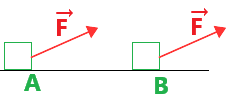
A constant force F→ is applied to this cube.
The work of F→ during this movement
represents the contribution of this force (in terms of energy transfer) during the AB displacement.
How can we evaluate the work of this force?
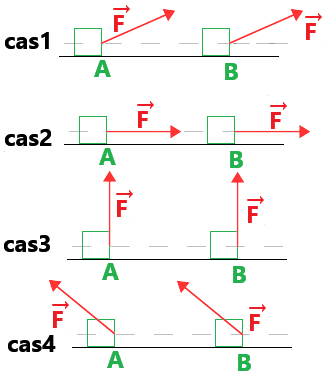
The force F→ is oriented in four different ways.
Answer the following quiz (3 answers expected):
2. Definition of Work of a Force
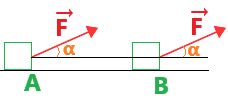
WAB(F→) = F→ . AB→ = F * AB * cosα
- WAB(F→) : work expressed in Joules (J)
- F : force value in Newtons (N)
- AB : displacement length in meters (m)
- α : angle between F→ and AB→ expressed in degrees or radians
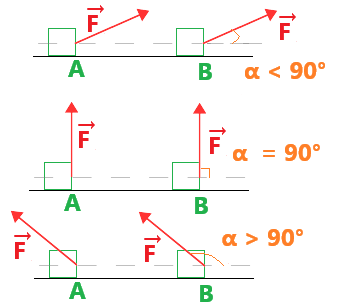
- α < 90° : W > 0 → the work is positive (favors movement).
- α = 90° : W = 0 → the work is zero.
- α > 90° : W < 0 → the work is negative (opposes movement).
3. The Special Case of the Work Done by the Reaction Force
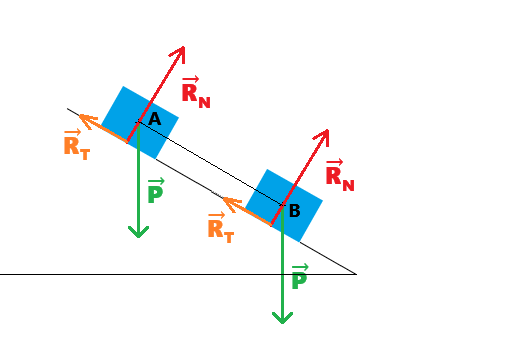
Forces acting on the box:
What can we say about the work done by the reaction force?
WAB(R→) = R→ . AB→ = R→N . AB→ + R→T . AB→
R→N . AB→ = 0 because R→N and AB→ are perpendicular.
R→T . AB→ = RT*AB*cos(180°) = -RT*AB
Thus: WAB(R→) = -RT*AB
Only the friction force (R→T) does work, opposing the motion.The work done by the friction force depends on the trajectory, making it a non-conservative force.
4. The Special Case of the Work Done by Weight
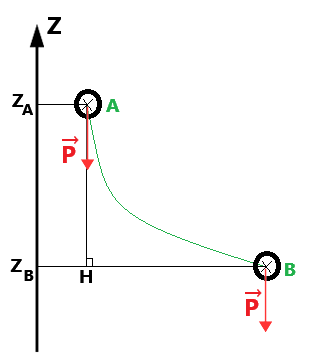
By definition, the work done by weight during the displacement is:
WAB(P→) = P→ . AB→
WAB(P→) = P→ . (AH→ + HB→)
WAB(P→) = P→ . AH→ + P→ . HB→
WAB(P→) = P→ . AH→ + 0 because P→ and HB→ are perpendicular.
WAB(P→) = mg(ZA-ZB) because P=mg and P→ and AH→ are collinear.
WAB(P→) = mg(ZA-ZB)
The work done by weight does not depend on the trajectory, making weight a conservative force.
5. The Kinetic Energy Theorem
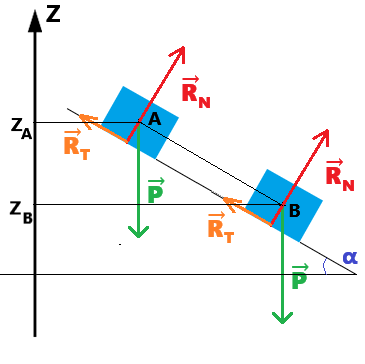
According to the kinetic energy theorem:
The variation in the kinetic energy of a system during a displacement AB
is equal to the sum of the works of the forces applied to it during the displacement AB.
ECB - ECA = ∑WAB(F→)
- ECB = 1/2mvB², the final kinetic energy at B, expressed in Joules (J).
- ECA = 1/2mvA², the initial kinetic energy at A, expressed in Joules (J).
- ∑WAB(F→), the sum of the works of all forces, expressed in Newton (N).
- vA and vB must be expressed in m/s.
ECB - ECA = ∑WAB(F→)
1/2mvB² - 1/2mvA² = WAB(RT→) + WAB(P→)
1/2mvB² - 1/2mvA² = -RT*((ZA-ZB)/sinα) + mg(ZA-ZB) because AB = (ZA-ZB)/sinα